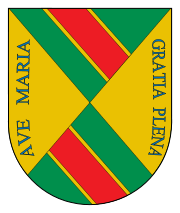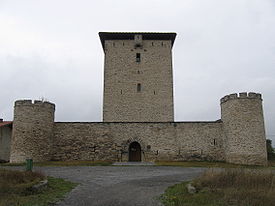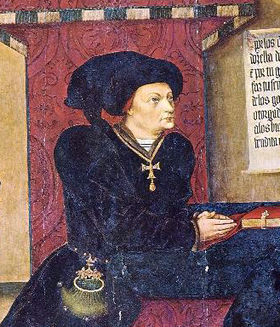
House of Mendoza
Encyclopedia

Spanish nobility
Spanish nobles are persons who possess the legal status of hereditary nobility according to the laws and traditions of the Spanish monarchy. A system of titles and honours of Spain and of the former kingdoms that constitute it comprise the Spanish nobility...
. Members of the family wielded considerable power, especially from the 14th to the 17th centuries in Castile
History of Spain
The history of Spain involves all the other peoples and nations within the Iberian peninsula formerly known as Hispania, and includes still today the nations of Andorra, Gibraltar, Portugal and Spain...
. The family originated from the town of Mendoza
Mendoza (Álava)
Mendoza is a village in Álava, Basque Country, Spain....
in the province of Álava in the Basque countries. The province became part of the Kingdom of Castile
Kingdom of Castile
Kingdom of Castile was one of the medieval kingdoms of the Iberian Peninsula. It emerged as a political autonomous entity in the 9th century. It was called County of Castile and was held in vassalage from the Kingdom of León. Its name comes from the host of castles constructed in the region...
during the reign of Alfonso XI (1312–1350), and the Mendozas participated in Castilian politics afterward, with its scions becoming advisers, administrators, and clerics.
Prehistory

Kingdom of Castile
Kingdom of Castile was one of the medieval kingdoms of the Iberian Peninsula. It emerged as a political autonomous entity in the 9th century. It was called County of Castile and was held in vassalage from the Kingdom of León. Its name comes from the host of castles constructed in the region...
, Aragon
Kingdom of Aragon
The Kingdom of Aragon was a medieval and early modern kingdom in the Iberian Peninsula, corresponding to the modern-day autonomous community of Aragon, in Spain...
, and Navarre
Kingdom of Navarre
The Kingdom of Navarre , originally the Kingdom of Pamplona, was a European kingdom which occupied lands on either side of the Pyrenees alongside the Atlantic Ocean....
in the 13th and 14th century. It had been loosely controlled by Navarre earlier, and retained its own distinctive customs and traditions. The town of Mendoza and the province of Álava itself was also a battlefield, where the clashing noble families of the area settled their disputes for generations. In 1332, the Mendozas had already been there at least a century, struggling with the rival clans such as Ayala, Orozco, and Velasco. They traced themselves as a stem of the House of Haro, another powerful clan of the Basque countries.
Once the region joined Castile, this interclan warfare generally ended, as they now jostled for position and privilege in Castile at large. By virtue of the Mendozas' status as knights and free men, they became Castilian nobility with the annexation (hidalgos). All members of the noble class were knights, administrators, or lawyers, and served in the administration of the realm. The largest family's responsibility was to form and maintain a local army that could make available if called by the king. The highest nobility became direct vassals of the king.
Gonzálo Yáñez de Mendoza
The first Mendoza to occupy a high position in Castile was Gonzálo Yáñez de Mendoza. During the ReconquistaReconquista
The Reconquista was a period of almost 800 years in the Middle Ages during which several Christian kingdoms succeeded in retaking the Muslim-controlled areas of the Iberian Peninsula broadly known as Al-Andalus...
, he fought in the Battle of Río Salado
Battle of Rio Salado
The Battle of Río Salado was a battle of King Afonso IV of Portugal and King Alfonso XI of Castile against sultan Abu al-Hasan 'Ali of the Marinid dynasty of Morocco and the Nasrid ruler Yusuf I of the Kingdom of Granada.-Campaign:...
in 1340 and the siege of Algeciras in 1344 against the Muslim kingdoms of Spain. He served as chief huntsman to King Alfonso XI
Alfonso XI of Castile
Alfonso XI was the king of Castile, León and Galicia.He was the son of Ferdinand IV of Castile and his wife Constance of Portugal. Upon his father's death in 1312, several disputes ensued over who would hold regency, which were resolved in 1313...
and settled in Guadalajara
Guadalajara
Guadalajara may refer to:In Mexico:*Guadalajara, Jalisco, the capital of the state of Jalisco and second largest city in Mexico**Guadalajara Metropolitan Area*University of Guadalajara, a public university in Guadalajara, Jalisco...
, which he ruled after marrying the sister of Íñigo López de Orozco. Orozco, another person originally from Álava, had received the post of mayor as a reward for his military services to the king. This pattern would later be replicated in the family several times: by serving the king in war, they would receive prestigious positions. Using these positions, they would then marry into power and wealth.
Pedro González de Mendoza
The son of Gonzálo, Pedro González de Mendoza (1340–1385) participated in the Castilian Civil WarCastilian Civil War
The Castilian Civil War lasted three years from 1366 to 1369. It became part of the larger conflict then raging between the Kingdom of England and the Kingdom of France: the Hundred Years' War...
. He aided the fortunes of his family greatly by siding with his stepbrother Henry II over Pedro the Cruel, as Henry's line eventually won the war. Pedro was taken prisoner by Edward, the Black Prince
Edward, the Black Prince
Edward of Woodstock, Prince of Wales, Duke of Cornwall, Prince of Aquitaine, KG was the eldest son of King Edward III of England and his wife Philippa of Hainault as well as father to King Richard II of England....
in the Battle of Najera, a crushing defeat for Henry's forces, but was eventually released after Edward left Pedro's side to return to England. Pedro was remembered as a hero for his actions in the Battle of Aljubarrota
Battle of Aljubarrota
The Battle of Aljubarrota was a battle fought between the Kingdom of Portugal and the Crown of Castile on 14 August 1385. Forces commanded by King John I of Portugal and his general Nuno Álvares Pereira, with the support of English allies, opposed the army of King John I of Castile with its...
, another crushing Castilian defeat. When King John I
John I of Castile
John I was the king of Crown of Castile, was the son of Henry II and of his wife Juana Manuel of Castile, daughter of Juan Manuel, Prince of Villena, head of a younger branch of the royal house of Castile...
's horse died, Pedro gave him his horse so that he could flee. Pedro was then slain in the battle with no way to escape. Still, his services were remembered, and the Mendoza family continued to grow in power and wealth.
Pedro was also a poet whose works include examples of the Galician tradition, a serrana, and coplas of a Jew's love.
Diego Hurtado de Mendoza
Diego Hurtado de Mendoza inherited the fortunes of his father Pedro. He married the illegitimate daughter of King Henry II, and later married Leonor de la Vega an exceptionally powerful and well-connected widow to the La Vega family. King Henry III appointed him Admiral of CastileAdmiral of Castile
Admiral of Castile was a post with a long and important history in Spain. One famous holder was Fadrique Enríquez.Another was Admiral Don Bernardo de Sarrià, Baron of Polop and nobleman in the service of King James II of Aragon....
, and he fought against Portugal as commander of the fleet. Still, of the three engagements he commanded, his forces lost in all of them.
When he died, he was considered among the richest men in Castile.
Íñigo López de Mendoza

External links
- Page dedicated to the Mendoza family, by Jose L. G. de Paz, Universidad Autónoma de Madrid.
- Castillo de Calahorra of the Marquis of Cenete.

